And make me aware of being alive.
Although their flight left a bit later in the morning than my family’s had, K, P & I said our goodbyes Tuesday night and when I awoke Wednesday morning not only was I on my own for the first time in three weeks but I had no more visitors scheduled to arrive. (Actually there was one small exception because my friend DB would be coming to visit for a quick overnight stay but although I was happily anticipating her arrival, it was nearly 10 days hence and required no significant advance planning.)
I had thoroughly enjoyed the past three weeks showing off a city that I love (and that may soon become a second home) to people that I love and, should I return to Lisboa on a long-term basis, would welcome new and repeat visitors. However, until I was entirely on my own again I’d been blissfully unaware of how tiring those three weeks (and frankly the two weeks of planning before that) had been.
Despite being in Lisboa for the third time in just more than 18 months and believing that I knew the city fairly well, there remained several places – neighborhoods, museums, etc. – that remained for my own journey of discovery. What I found during those first few days on my own was that I had neither the energy nor the desire to embark on those explorations. Those early days were confined to reading, writing, research, and walks in the nearby neighborhoods I knew. Since I promised only to write about new experiences my coverage for these days will be spare mainly limited to the photos.
Thursday 18 January.
During K & P’s visit we walked, on average, 15.6 kilometers daily including some long stretches along the hills of Lisboa. I felt I’d earned a bit of a break so I kept my Thursday walk mainly along the Tejo – one of the flattest routes available in Lisboa. Since it had been closing when we visited, I went first to the Mercado da Ribeira to take some photos for P & K so they could see the breadth of this market.
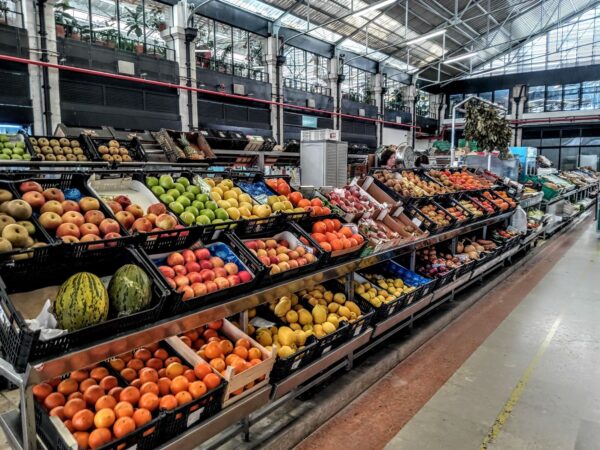
In the process, I walked past this Bordalo II cat (that I’d somehow never noticed!),
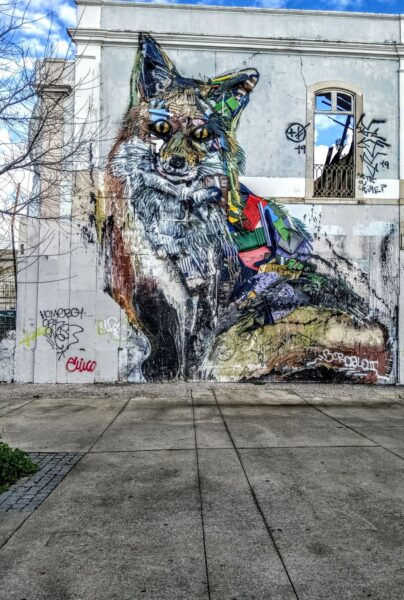
and some other wall art that I thought merited photos before finally snapping this photo of the “Christmas tree” in Terreiro do Paço being dismantled.
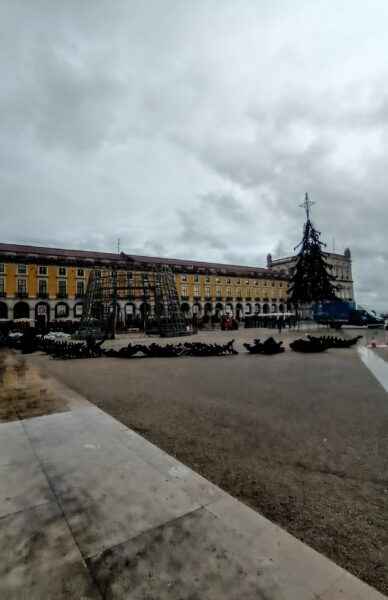
19 January 2024.
Following my flat and relatively short walk Thursday, I was in the mood to tackle some hills Friday so I started by walking up to the Chiado area of the neighborhood. Rather than taking one of my customary paths, I walked down to r. Conceiçao and followed the route of Tram 28E up the Calçada de São Francisco though I didn’t follow it all the way to Praça Luis Camões. (I think my motivation was to be able to say that throughout my stays in Lisboa I’d collectively walked the entire route of the 28E.)
I walked past the MNAC (National Museum of Contemporary Art) to the Teatro Nacional de São Carlos home of both the Coro do Teatro Nacional de São Carlos (São Carlos National Theater Chorus) and Orquestra Sinfónica Portuguesa (Portuguese Symphony Orchestra). Standing on the opposite side of the plaza from the theater is this curious, yet appropriate, statue of Fernando Pessoa.
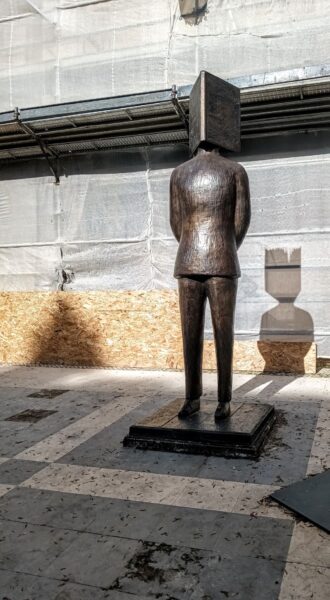
But I wasn’t quite done yet. I returned to the flat after wandering around Chiado and the edges of Bairro Alto done with my morning walk. After lunch, I set out again this time toward Praça Martim Moniz and the hills of Mouraria. I wanted to return there because earlier in the week P, K and I had walked along r. Capelão where there’s a tribute wall celebrating many famous fadistas who called this neighborhood home and I hadn’t taken a photo of all the plaques such as this one featuring Argentina Santos.
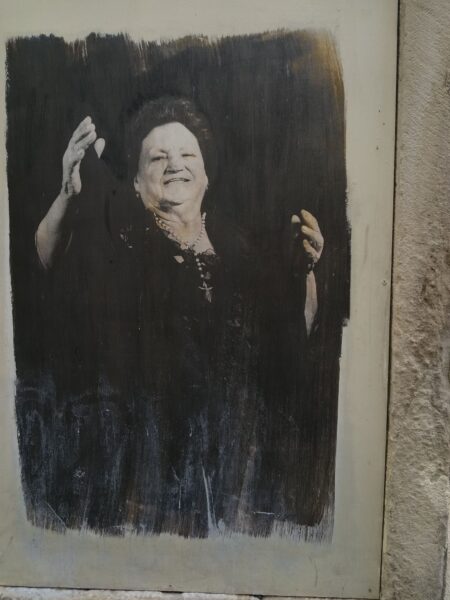
I wandered through Mouraria into Alfama and eventually back to my apartment in Baixa. You can see the photos I took here.
The world turns to face the sun and start another day.
20 January 2024 – 23 January 2024.
These four days were quite routine. A walk after breakfast followed by a return to the apartment. Have a light lunch then work on the posts from my Michigan trip followed by an afternoon walk. It wasn’t until Monday (22nd) that I ventured into a combination of familiar and unfamiliar neighborhoods. On Saturday, I did revisit the Feira da Ladra in Campo de Santa Clara where I purchased a belt for myself and a few small gifts for friends and family.
Monday brought a bit of a change. Although I’d been adjacent to and passed through the area in Lisboa called Arroios, I’d never really explored it and since I wanted to spend some time at the Jardim do Torel which is nearby, this was a good day to walk around this part of Arroios and where I discovered the Colina de Sant’Ana and the Jardim Braancamp Freire. Another name attached to this area is Campo dos Mártires da Pátria (Field of the Martyrs of the Fatherland) where I first saw this memorial. It has

yet a third moniker – Colina da Medicina or Medicine Hill. All of these roused my curiosity but in the moment, the more curious element of this park was the roosters wandering through it undisturbed. (I never discovered why.)

Of course I had to learn how it earned so many different appellations and that requires a bit of a historical journey.
The crest of the hill sits on a high plateau above the two valleys that have for centuries been the two main routes north out of Lisboa. These are now the Avenida da Liberdade (Vale Verde) and the Avenida Almirante Reis (Vale da Ribeira Arroios). From this perch above the old town and port, wealthy families built villas from which they had a view of the comings and goings of not merely their businesses but the ships along the Teju as well.
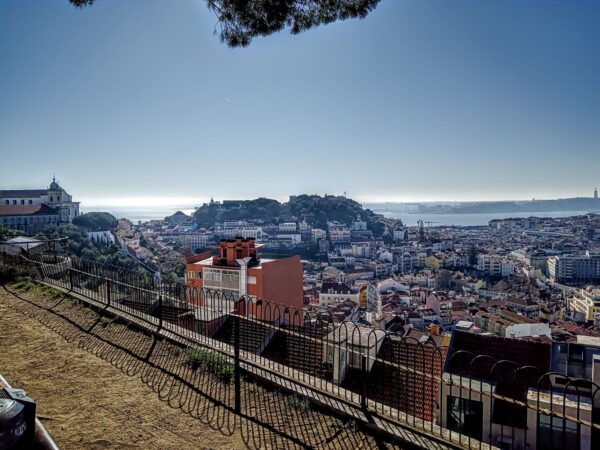
In its earliest days the plateau was called Campo do Corral because it was outside the city walls and consisted of mainly fields and orchards. By the beginning of the fourteenth century the city had erected the Gafaria de São Lázaro which was an institution for lepers. Thus, when the Black Plague reached Lisboa in the middle of the fourteenth century, the campo (Portuguese for field) became the natural place to quarantine the sick to try and prevent the spread of the disease.
In the sixteenth century slaughterhouses and fish factories located there. Beginning in 1831 and for nearly 60 years thereafter people could come and watch bullfights at the bull ring constructed quite close to the site of the monument in the photo above. Also, the Feira da Ladra was originally held there from 1835 to 1882.
Then the Portuguese world changed. The 1755 earthquake destroyed the Todos os Santos Hospital located in Rossio. At that time, and, because the Jesuits had been expelled, the unoccupied religious school of Santo Antão-o-Novo became the home of the Hospital Real de São José that is still in operation today. Led largely by the efforts of Doctor Sousa Martins, other health-related services were established here throughout the nineteenth century. These include the first Faculty of Medicine of Lisbon, the first psychiatric hospital in Portugal (Hospital Miguel Bombarda), the Bacteriological Institute Câmara Pestana, the Ophthalmic Institute Gama Pinto, and the Hospital Santo António dos Capuchos. This is the source of its moniker as Camilo da Medicina or Medicine Hill.
As for some of its other names, Campo de Santana originated from Sant’Ana and the remains of a nearby Convent. The name Campo dos Mártires da Pátria stems from an incident on 18 October 1817 as explained on this marker.
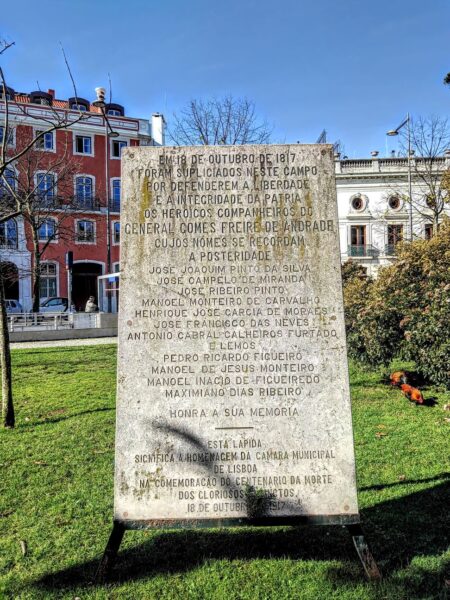
On this date it was the site of the execution of General Gomes Freire de Andrade and eleven co-conspirators who had been accused of rebellion by General William Beresford, the British Commander of the Portuguese Army after the Peninsular War. Subsequent events, including the Liberal Revolution of 1820 turned these men into Martyrs of the Fatherland.
On the 23rd, my walk was largely confined to Graça, Alfama, and a stretch along the river from the Santa Apolónia Station back to Baixa and my flat. If you want to see more photos from these four days, you can do so here.
New hat in the photos? ?
Indeed it is. Good color, no?
Looks like Terps red to me!
As close as I could get to that in Lisboa.